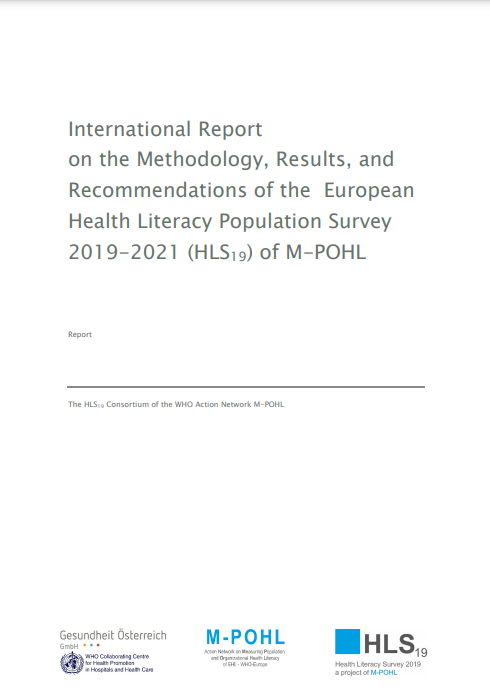
-
Source
International Report on the Methodology, Results, and Recommendations of the European Health Literacy Population Survey 2019-2021 (HLS19) of M-POHL
Background/Research Topics/Partner Countries
In Europe, interest has grown in measuring the health literacy (HL) of the adult population in relation to public health, disease prevention, and health promotion to inform health policy in the new millennium, partly building on a longer tradition of measuring HL, but with a focus on patients, in the US. The European Health Literacy Survey (HLS-EU, 2009-2012) confirmed the relevance of HL for people’s health for eight countries in the European Union, and this was replicated in follow up-studies for more European and Asian countries. All of these studies demonstrated that HL is limited in a considerable proportion of the general population, with a social gradient for HL and problematic consequences of limited HL for healthy lifestyles, self-reported health, and the utilization of health care services. Following the recommendations of the WHO’s Health Literacy: The solid facts (2013), WHO/Europe initiated the Action Network on Measuring Population and Organizational Health Literacy (M-POHL), with 28 countries involved, to measure HL regularly, starting with the Health Literacy Survey 2019 (HLS19). This survey was carried out in 17 countries in the WHO European Region (Austria, Belgium, Bulgaria, Czech Republic, Denmark, France, Germany, Hungary, Ireland, Israel, Italy, Norway, Portugal, Russian Federation, Slovakia, Slovenia, and Switzerland). In the HLS19 not only General HL was investigated but also specific HLs, namely Navigational HL, Communicative HL with physicians, Digital HL, and Vaccination HL, using newly developed and validated instruments. Furthermore, HL and health-related quality of life was analyzed as a mediator for health costs.
Methods
The HLS19 applied a cross-sectional multi-center survey study design. The study population was defined as all permanent residents aged 18 and above living in private households in the participating countries. A total of 42,445 interviews were included in the study. National sample sizes were expected to be at least 1,000 but varied from 865 to 5,660 respondents. The participating countries used a multi-stage random sampling procedure or quota sampling, and most countries stratified samples by gender, age group, population density, and geographical areas/units. Data were collected in personal, telephone, or web-based interviews, or by using a mix of these. The timeframe for data collection was from November 2019 to June 2021.
To measure General HL across the 17 countries, a short form of the original HLS-EU-Q47 instrument – the HLS19-Q12 – was validated and used. At the same time, new instruments were developed and validated to measure Navigational HL, Communicative HL with physicians, Digital HL, and Vaccination HL which were used by between 7 to 13 volunteering countries. Reflecting the HLS-EU definition for comprehensive, general HL, explicit definitions were drawn up for these specific HLs, and items were selected or constructed based on these. Relevant correlates of HL were also measured in the HLS19. The HLS19 instruments were translated into their national language(s) by 16 out of the 17 countries and also into migrant languages by a few countries. For HL measures, a score was calculated by combining the categories “easy” and “very easy”, and standardizing it from 0 to 100, with higher values indicating a higher level of HL. For General HL, four categorial levels were also constructed (excellent, sufficient, problematic, inadequate).
Results/Findings
Psychometric properties of the HLS19 instruments: The internal consistency (Cronbach’s alpha) of all HL scales was good (Cronbach’s alpha). For all measures, and for most countries, the distribution of scores was negatively skewed, with a ceiling effect. Thus, the instruments are sensitive especially for respondents with lower HL. Unidimensionality of the scale was confirmed by CFA and Rasch models, with acceptable results for all scales. Based on moderate correlations with the General HL measure and with each other, all four specific measures are deemed sufficiently independent to measure a specific aspect of HL.
The most difficult tasks identified were as follows: General HL: judging different treatment options, protecting oneself from illness using information from the mass media, finding information on how to handle mental problems; Navigational HL: understanding information on health care reforms, judging the suitability of health services, finding out about patients’ rights, judging the extent of health insurance coverage; Communicative HL: getting enough time from physicians, expressing personal views and preferences; Digital HL: judging the reliability of information, judging whether information is offered with commercial interests, using information to help solve a health problem; Vaccination HL: judging which vaccinations one needs, finding information on recommended vaccinations.
Disadvantaged vulnerable subpopulations at risk of lower General HL and lower specific HLs than their national averages were identified. Having poor self-perceived health, being financially deprived, and having a lower level in society were indicators for lower General and lower specific HLs. People with a low education also had, on average, lower General, Digital, and Vaccination HL. To investigate a social gradient, the indicators gender, age, education, perceived social status, and financial deprivation were used in a linear regression model. A social gradient was demonstrated for all countries, albeit differing in degree across countries. The strongest predictors in the model for a social gradient were financial deprivation and self-perceived level in society for all HLs. Further relevant predictors were education for Navigational, Communicative, and Vaccination HLs as well as age for Digital HL.
Using multiple linear regression analyses, the potential effects of General HL and specific HLs were tested. Concerning General HL, out of the five lifestyle indicators, significant positive potential effects were shown for physical activity (12 countries), fruit and vegetable consumption (8 countries), alcohol consumption (4 countries), BMI (2 countries), and smoking behavior (2 countries). For three indicators of health status, significant positive potential effects were demonstrated for self-perceived health (all 17 countries), limitations in activities due to health problems (13 countries), and long-term illness/health problems (7 countries). For the utilization of five types of health services, fewer contacts with higher HL were found for GPs/family doctors (9 countries), emergency services (8 countries), medical or surgical specialists (4 countries), inpatient hospital services (4 countries), and day patient hospital services (2 countries). Thus, General HL is relevant for people’s health but to a different degree concerning indicators and for individual countries.
Concerning specific HLs, Navigational HL, measured in eight countries, had a significant potential positive effect on self-perceived health (7 countries), limitations in activities due to health problems (5 countries), and long-term illness/health problems (2 countries). Higher Communicative HL, measured in nine countries, had a significant potential positive effect on self-perceived health in seven countries. Digital HL, measured in 13 countries, had a significant potential positive effect on self-perceived health (9 countries) and the utilization of GPs/family doctors (7 countries), when General HL was also included in the regression models. Vaccination HL had a significant potential positive effect on self-reported vaccination behavior in five out of the seven countries, a relationship which is at least partly mediated by confidence in vaccinations, risk knowledge, and risk perception.
To sum up, the results demonstrated the relevance of General and specific HLs for considerable proportions of adult residents with low HLs, a social gradient for HLs, and significant potential effects of HLs with health-relevant indicators. For all results, there were considerable variations across countries, which confirms that HL is a contextual concept and must be measured for each country. Due to the different methods and times of data collection, however, differences across individual countries must be interpreted with caution, as must any causal assumptions about potential effects due to the cross-sectional study design.
Recommendations
Based on the HLS19 results, the HLS19 consortium agreed on a set of recommendations, presented here in a shortened format.
Regarding General HL
- Health policy should include an investment in longitudinal studies, measuring and monitoring population HL regularly, and should systematically implement interventions to improve HL.
- Interventions should be specifically targeted at at-risk groups for low HL to reduce the health gap between groups.
- Interventions to improve HL should focus on all four aspects of processing health-related information (accessing, understanding, appraising, and applying information) within the domains of healthcare, disease prevention, and health promotion.
- For interventions related to specific, concrete HL tasks, the tasks that are experienced as being more difficult should be prioritized.
- The quality of health information in the mass media should be improved.
- Interventions to improve HL in relation to mental health should be prioritized and supported by specific research.
Regarding specific HLs
- Health policy should develop strategies to improve people’s Navigational HL, specifically interventions on systemic and organizational levels to make health systems more health-literate, user-friendly, and easier to navigate.
- Interventions to improve the communication of health professionals with patients should have high priority. Specifically, support for health professionals, especially physicians, in dedicating more time to person-centered communication is needed.
- Regarding Digital HL, emphasis on providing easily accessible, high quality, trustworthy, understandable, assessable, and applicable health information, as well as communication via digital sources should be increased.
- Improving Vaccination HL should have top priority, with a focus on judging vaccination information by improving the trustworthiness of information and communication on vaccinations.
Regarding research on HL
- The HL of the adult resident population should be measured regularly in as many countries as possible.
- The next wave of measuring should be planned for data collection in 2024.
- In preparation for this next wave, more specific research should be funded to analyze existing data in more depth as well as to revise, extend, and apply the tools for measuring HL and relevant correlates.
- For the four specific HLs, more detailed analyses and publications on the HLS19 data are needed as well as further research and development on improvements for later applications.
- Additionally, further specific health literacies or relevant topics of General HL should be reviewed, selected, and researched to be included in the next wave of measuring HLs.
- More detailed analyses are needed regarding the costs and economics of HL.
- Further dissemination of the results of the HLS19 through peer-reviewed scientific publications is required.




